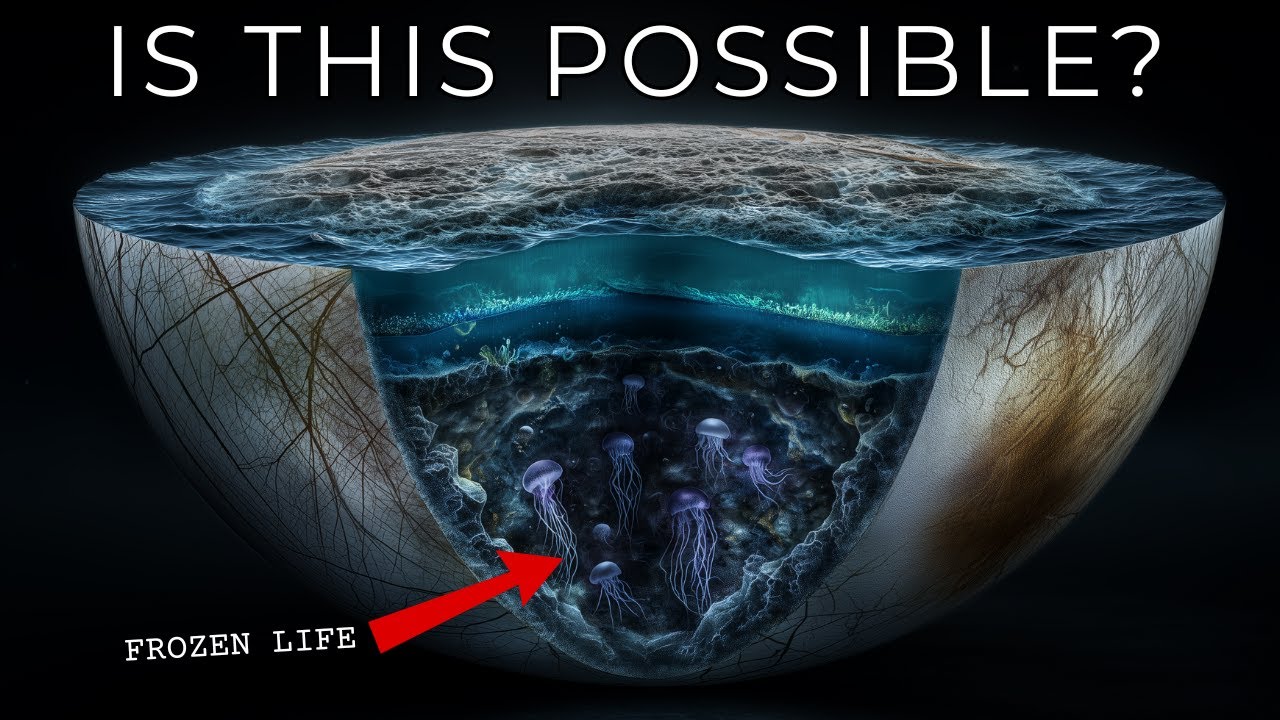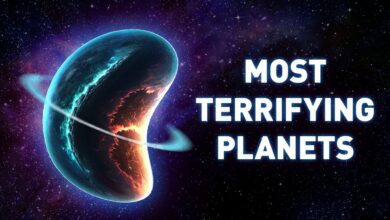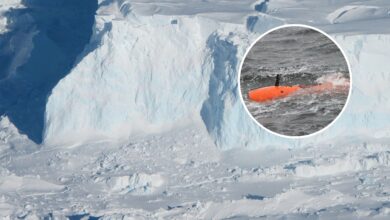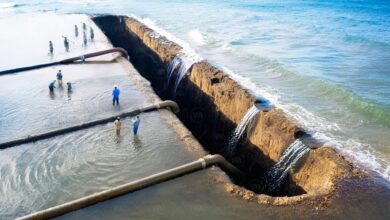If This Is Real, Europa Might Be Hiding Something Alive…

Last year, NASA launched a spacecraft—not to Mars, not to Saturn—but to an icy moon few people ever think about: Europa, a small world orbiting Jupiter. Europa is a frozen, locked world beneath a shell of ice, with no sunlight, no air, and seemingly no reason to expect life. Yet scientists are betting big on it, ready to spend billions of dollars and wait six years just to fly past it over and over again. Because beneath that thick layer of ice, Europa might be hiding something crucial—not cities or civilizations, but life. Life that didn’t start on Earth, that never needed Earth’s conditions, and that might prove we’re not alone in the universe.
Interestingly, while this spacecraft is on its way to Europa, NASA has been developing underwater robots—not just to explore Europa, but also to study Earth’s own oceans. This isn’t a side project; it’s part of the plan. Because before we can explore an alien ocean, we need to know how to survive in our own. And that’s where this story truly begins—in the dark, frigid depths beneath our own waves.
Compared to other celestial bodies, Europa doesn’t stand out. It has no brilliant rings like Saturn, no raging storms like Jupiter, and no erupting volcanoes like Io. From afar, it appears as a smooth, icy sphere marked with reddish cracks—cold, quiet, and almost boring. But that’s only the surface. Hidden beneath an ice layer estimated between 15 and 25 kilometers thick is a vast, liquid ocean spanning the entire moon, potentially up to 100 kilometers deep—containing more water than all of Earth’s oceans combined. Though trapped beneath solid ice, this water remains liquid thanks to heat generated from within the moon.
The surprising part is that Europa lies more than 600 million kilometers from the Sun, receiving little light and almost no warmth. So how can there be liquid water? The answer lies in friction. As Europa orbits Jupiter, it’s constantly being stretched and squeezed by the planet’s immense gravity, much like bending a paperclip repeatedly until it heats up. This process generates internal heat, enough to keep the ocean from freezing solid.
This isn’t just theory. In 2012 and 2016, telescopes detected plumes of water vapor erupting from Europa’s surface like geysers blasting into space. Though not constant or widespread, these events hint at something active happening beneath the ice. That’s why Europa matters: where there’s liquid water, internal heat, and chemical reactions between rock and ocean, you have the three fundamental ingredients for life as we know it. No sunlight, no plants—just heat, water, and chemistry. The same conditions exist at Earth’s ocean floors, where bizarre life forms thrive around hydrothermal vents in total darkness.
This has changed our view of where life might exist. For decades, scientists believed life required sunlight: plants use it, animals eat plants, and virtually all Earth’s life depends on the Sun. So, the idea of life in cold, dark places buried under kilometers of ice once seemed impossible. Until we discovered hydrothermal vents deep in Earth’s oceans—places where water nearly boils, pressure can crush steel, and toxic chemicals abound—yet they teem with life. Bacteria there don’t rely on sunlight but instead harness chemical energy from compounds like hydrogen sulfide. Around them thrive entire ecosystems of giant tube worms, blind shrimp, and strange crustaceans that have never seen light. This discovery changed everything. If life can exist in such extreme environments on Earth, Europa might have the same potential—a salty ocean, rocky seafloor, internal heat from tidal forces, and possibly hydrothermal vents supplying steady energy and nutrients. A food web based on chemistry, not sunlight.
Of course, Europa might also be a dead, sterile ocean. But given what we’ve learned on Earth, it’s not unreasonable to think there could be at least microbial life—perhaps clinging to vents, drifting in the darkness, or living in pockets of warmer water beneath the ice. And this is no longer just speculation. NASA is actively preparing to explore places like this. Because if we find life on Europa—even simple bacteria—it would prove that life doesn’t require Earth to begin. It wouldn’t need our sunlight, our atmosphere, or our special conditions. It would mean life could arise anywhere the right ingredients exist, fundamentally transforming our understanding of the universe.
That’s why NASA launched Europa Clipper in October 2024 aboard a Falcon Heavy rocket. No humans, no lander—just a large, heavily shielded machine dedicated to answering one question: could Europa support life? This isn’t just another quick flyby like previous missions. It’s a multi-year mission designed to get as close to Europa as possible, as often as possible, gathering data to reveal what’s truly happening beneath the ice.
Europa Clipper is now traveling through the solar system, using a series of gravity assists from Mars and Earth to build up speed and reach Jupiter on a precise trajectory. If all goes as planned, it will arrive at Europa in April 2030. Rather than orbiting Europa itself, it will orbit Jupiter, performing 49 close flybys of Europa over four years. Some of these passes will bring it within 25 kilometers of the surface—closer than many commercial jets fly above Earth. During each approach, Clipper will scan, probe, and record data.
Onboard are advanced instruments like the Reason radar, capable of peering through ice to measure thickness and internal structure, potentially locating pockets of liquid or areas where the ocean comes near the surface. The Europa Thermal Emission Imaging System (Etheis) will search for heat signatures that could indicate plumes or subsurface lakes. Clipper also carries a magnetometer to measure how Europa’s magnetic field is distorted by Jupiter’s intense radiation belts. These distortions help determine the depth and salinity of the ocean and whether it interacts with the rocky seafloor—a crucial factor for energy, chemistry, and possibly life. In addition, spectrometers will scan the surface for salts, organic molecules, or other complex compounds. A dust analyzer could capture tiny particles from possible plumes. High-resolution cameras will map Europa’s surface in unprecedented detail, revealing cracks, ridges, chaotic terrains, and perhaps openings into the ocean below.
However, Clipper isn’t designed to directly detect life. It won’t land, drill, or collect samples. Its job is to scout—to identify the most promising places for a future mission to investigate more closely. Landing on Europa is incredibly challenging. The surface is unpredictable, radiation levels are extreme, hundreds of times higher than Earth’s. There’s no atmosphere to slow descent, no GPS, and hazardous terrain. Before risking a lander, we must know exactly where to go: somewhere safe enough to land, thin enough to penetrate, and promising enough not to drill into nothing. Europa Clipper is how we find that place.
Meanwhile, NASA is developing the technologies needed for future exploration. From under-ice explorers like BRUIE—a robot designed to hang upside down beneath thick ice—to deep-diving robots like SUBA, built for studying hydrothermal vents where water approaches boiling and conditions are lethal. Projects like IceNode, sensor arrays designed to sit under Antarctic ice for months or years, silently measuring temperature, salinity, melt rates, and pressure, are also underway. Then there are “swimbots”—tiny, independent robotic swimmers the size of a hand, designed to scatter and collect data across a broad area. All this technology is being developed both for Earth and for Europa. Every deep-sea test on Earth is a rehearsal for a mission 628 million kilometers away. Because on Europa, there’s no fixing a broken robot. There’s no second chance.
If one day, our probes make it through Europa’s ice and detect signs of life—a cluster of cells, a hint of metabolism, or an unexpected molecule—it would become the single most significant biological discovery in human history. Scientists would rigorously analyze every piece of data to rule out contamination, because such a claim would transform science and humanity’s place in the cosmos. It would mean life isn’t a fluke unique to Earth. That it could be a natural outcome wherever conditions are right. And that would change everything. If life exists on Europa, where else might it thrive? Titan, with its methane lakes? Enceladus, with its plumes and subsurface ocean? Exoplanets light-years away? Rogue planets drifting between stars? If biology doesn’t require sunshine, then our search for life has been far too narrow. Suddenly, the universe goes from feeling empty to brimming with possibilities.
And beyond the science, there’s a deeper, human dimension. If life arose more than once, independently, it suggests life has likely arisen many times. That biology might be a feature of the universe, not a rare accident. And that humanity is merely one branch on a vast, ancient tree of life. It wouldn’t matter if the organisms were microbes, simple or bizarre. Their mere existence would mean we’re not alone—not spiritually, not biologically, and not statistically. And that realization could shift our perspectives on evolution, consciousness, and the very nature of life.
We’d also face new ethical questions. Should we bring samples back? Should we leave alien life undisturbed? What if it’s fragile? What if we pose a threat simply by arriving? And most provocatively, what if it’s intelligent in a way we don’t yet understand? Life that evolved independently might not resemble anything we know—it might lack nerves, eyes, language, or bones—but that doesn’t mean it’s unaware. And if it’s aware, even on the tiniest level, we’re no longer merely exploring—we’re encountering.
That’s why so much care goes into these missions. Why sterilization is so extreme. Why every robot is built as if it’s entering a sacred place. Because, for all we know, it is. And perhaps the biggest shift won’t be scientific at all, but emotional. For the first time, the idea that life exists elsewhere wouldn’t be theoretical. It would be real, confirmed, alive—and the stars would suddenly feel a little less distant.
Many people overlook one crucial fact: this isn’t some distant dream. It’s not a sci-fi fantasy far in the future. The search for life on Europa isn’t happening “one day”—it’s already happening right now. Europa Clipper is in flight. That’s not speculation—it’s reality. The spacecraft launched last year. Its course is set. The mission is active. At this very moment, it’s silently sailing through the solar system on a six-year journey that will culminate in a spacecraft orbiting Jupiter and flying closer to Europa than anything ever has.
Meanwhile, back on Earth, NASA and its partners aren’t waiting for Clipper to finish its mission. They’re building the next generation of tools right now. Cryobots, submersibles, swarm bots, power systems capable of surviving without repairs, sterilization protocols to prevent contamination—every piece of the future Europa mission is being forged in real time. In fact, you could argue that the mission to Europa began long before launch. It began in the Arctic when BRUIE crawled beneath Antarctic ice. It began at deep-sea hydrothermal vents where SUBA gathered chemical data from environments utterly unlike Earth’s surface. It began when NASA looked into Earth’s ocean depths and said, “This is what Europa might feel like.”
That’s why the timing matters so much. For the first time in history, everything is aligning. We have the spacecraft. We have the target. We have the technology. We have the training grounds on Earth. We’re not just talking about searching for life anymore—we’re actively building the systems to find it. And the world is watching closer than ever. With every detected plume, every new hint of subsurface heat, interest grows—not only among scientists, but across governments, institutions, and even private companies. Because finding life beyond Earth is no longer just about curiosity—it’s about legacy. It’s about making history.
There’s also an urgency we rarely discuss. Europa is dynamic. It changes. Plumes open and close. Surface cracks shift. Radiation environments worsen. Waiting too long might mean missing the moment when something was detectable, reachable, or active. Space missions take decades to plan. Missing this opportunity could push the next attempt into the next generation.
That’s why this moment matters. Right now, the pieces are moving. Scientists who have spent their careers arguing that Europa might harbor life are finally getting the tools to find out. Engineers who sketched ice-penetrating probe designs years ago are now building them. Test dives are no longer concepts—they’re happening under Arctic ice, on the ocean floor, and in cleanrooms preparing hardware for deep space. It’s happening quickly—and right on time. And when Europa Clipper starts sending back high-resolution maps, radiation measurements, and ice-penetrating scans, all that Earth-based work will accelerate. We’ll know where to land, what to build next, where the ice is thinnest, where energy is concentrated, and where to look when we finally decide to go in.
So yes, it matters now. Because the future we’ve been waiting for isn’t some distant vision stuck in imagination—it’s on its way. For centuries, we’ve looked to the skies for answers. We’ve sent telescopes to the universe’s edge, probes to distant planets, and robots to moons barely visible to the naked eye. But perhaps we’ve been overlooking something. Because while we’ve been busy chasing galaxies and dreaming of alien life, we’ve barely scratched the surface of the world that’s always been right here—the one beneath our own oceans. And that’s not just poetic—it’s practical. Everything we hope to do on Europa—every scan, every dive, every search for life—we’ve been learning how to do by studying Earth, quietly, carefully, piece by piece. Not in sci-fi labs, but in dark waters filled with pressure, chemistry, and life that plays by no rules but its own.
We want to explore an alien ocean? Well, we have one right here. And what it’s teaching us is more profound than most people realize. It’s teaching us that life doesn’t need comfort. That it doesn’t care about the Sun. That it adapts, evolves, and survives in places we once thought impossible. The vents, the bacteria, the robotic dives—they’re not side projects. They’re the closest thing we have to a guidebook for what might await beneath Europa’s crust. The next time we talk about space exploration, it won’t just be about launch dates or orbital mechanics. It’ll be about ecosystems thriving in darkness, about life powered by chemistry rather than starlight, and about machines swimming through alien seas no human has ever seen—but that somehow feel familiar. Because the deepest clues about life beyond Earth were never light-years away. They’ve been hiding all along, beneath our feet. So as Europa Clipper sails through space and our ocean robots continue venturing into the unknown, we’re not merely preparing to visit another world. We’re finally beginning to understand this one. And perhaps, that’s what will make all the difference when we arrive.








